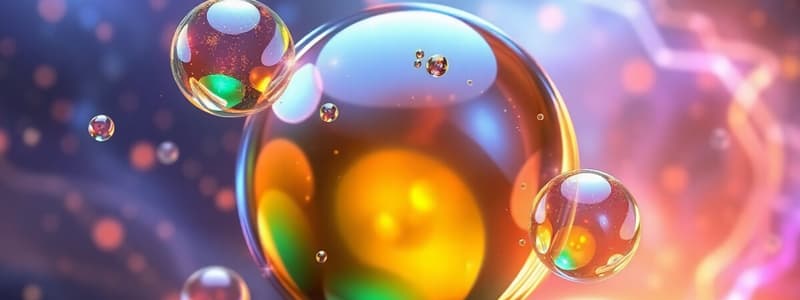Podcast
Questions and Answers
Which of the following describes the process by which an atom becomes a negatively charged ion?
Which of the following describes the process by which an atom becomes a negatively charged ion?
- Losing protons
- Gaining electrons (correct)
- Losing neutrons
- Gaining protons
What distinguishes a monatomic ion from a polyatomic ion?
What distinguishes a monatomic ion from a polyatomic ion?
- Monatomic ions are formed from a single atom, while polyatomic ions are formed from multiple atoms. (correct)
- Monatomic ions are positively charged, while polyatomic ions are negatively charged.
- Monatomic ions are larger in size compared to polyatomic ions.
- Monatomic ions are formed through covalent bonds, while polyatomic ions are formed through ionic bonds.
If a neutral sulfur atom gains two electrons, what is the correct name and symbol for the resulting ion?
If a neutral sulfur atom gains two electrons, what is the correct name and symbol for the resulting ion?
- Sulfur(II) ion, $S^{2+}$
- Sulfur, $S$
- Sulfate, $SO_4^{2-}$
- Sulfide, $S^{2-}$ (correct)
What is the correct name for $Fe^{3+}$ in ionic compounds, considering iron can form multiple cations?
What is the correct name for $Fe^{3+}$ in ionic compounds, considering iron can form multiple cations?
Which of the following statements correctly describes the naming convention for monatomic anions?
Which of the following statements correctly describes the naming convention for monatomic anions?
Which of the following is the correct name for the $Cu^+$ ion, considering copper can form multiple cations?
Which of the following is the correct name for the $Cu^+$ ion, considering copper can form multiple cations?
What characteristic defines polyatomic ions?
What characteristic defines polyatomic ions?
What distinguishes the naming convention of monatomic cations that can form multiple ions compared to those that typically form only one type of cation?
What distinguishes the naming convention of monatomic cations that can form multiple ions compared to those that typically form only one type of cation?
Which of the following pairs of polyatomic ions demonstrates the 'hydrogen' naming convention, indicating the presence of additional hydrogen ions?
Which of the following pairs of polyatomic ions demonstrates the 'hydrogen' naming convention, indicating the presence of additional hydrogen ions?
If an oxyanion has one less oxygen atom than the '-ite' ion, what prefix should be used in its name?
If an oxyanion has one less oxygen atom than the '-ite' ion, what prefix should be used in its name?
What is the correct name for $CuSO₄ \cdot 5H₂O$, given the rules for naming ionic compounds and hydrates?
What is the correct name for $CuSO₄ \cdot 5H₂O$, given the rules for naming ionic compounds and hydrates?
Which of the following statements accurately describes the naming convention for monatomic anions?
Which of the following statements accurately describes the naming convention for monatomic anions?
How is the charge of a transition metal cation indicated when naming an ionic compound?
How is the charge of a transition metal cation indicated when naming an ionic compound?
Which of the following is the correct formula for dichromate ion?
Which of the following is the correct formula for dichromate ion?
What prefix indicates that an ionic compound is associated with four water molecules in its crystal structure?
What prefix indicates that an ionic compound is associated with four water molecules in its crystal structure?
Identify the pair in which the first compound contains one more oxygen atom than the second.
Identify the pair in which the first compound contains one more oxygen atom than the second.
Which formula represents an oxyanion in which the central atom is bonded to four oxygen atoms?
Which formula represents an oxyanion in which the central atom is bonded to four oxygen atoms?
In which of the following pairs does the first formula contain one less oxygen atom than the second?
In which of the following pairs does the first formula contain one less oxygen atom than the second?
Which of the following pairs contains a monatomic cation and a polyatomic anion, respectively?
Which of the following pairs contains a monatomic cation and a polyatomic anion, respectively?
What is the correct formula for the iron(II) ion, and why is the Roman numeral used in its name?
What is the correct formula for the iron(II) ion, and why is the Roman numeral used in its name?
Which of the following scenarios would necessitate using the Stock system (Roman numerals) for naming a cation?
Which of the following scenarios would necessitate using the Stock system (Roman numerals) for naming a cation?
Which of the following is the correct name for $N^{3-}$?
Which of the following is the correct name for $N^{3-}$?
Which of the following ions is most likely to form when potassium (K) reacts to form an ionic compound?
Which of the following ions is most likely to form when potassium (K) reacts to form an ionic compound?
Which of the following polyatomic ions contains the fewest oxygen atoms?
Which of the following polyatomic ions contains the fewest oxygen atoms?
What is the key difference in the number of oxygen atoms between sulfite and sulfate ions?
What is the key difference in the number of oxygen atoms between sulfite and sulfate ions?
Which of the following statements correctly describes the use of the prefixes 'hypo-' and 'per-' in naming oxyanions?
Which of the following statements correctly describes the use of the prefixes 'hypo-' and 'per-' in naming oxyanions?
Which of the following formulas represents an ion formed with hydrogen that still retains a negative charge?
Which of the following formulas represents an ion formed with hydrogen that still retains a negative charge?
Why is it important to memorize the charges of common polyatomic ions when writing chemical formulas for ionic compounds?
Why is it important to memorize the charges of common polyatomic ions when writing chemical formulas for ionic compounds?
Flashcards
Ions
Ions
Atoms or groups of atoms with an electrical charge due to the loss or gain of electrons.
Anion
Anion
A negatively charged ion formed when an atom gains electrons.
Cation
Cation
A positively charged ion formed when an atom loses electrons.
Monatomic Ions
Monatomic Ions
Signup and view all the flashcards
Polyatomic Ions
Polyatomic Ions
Signup and view all the flashcards
Monatomic Anions
Monatomic Anions
Signup and view all the flashcards
Monatomic Cations
Monatomic Cations
Signup and view all the flashcards
Polyatomic Ions
Polyatomic Ions
Signup and view all the flashcards
Nitrate Ion
Nitrate Ion
Signup and view all the flashcards
Sulfate Ion
Sulfate Ion
Signup and view all the flashcards
Phosphate Ion
Phosphate Ion
Signup and view all the flashcards
Oxyanions
Oxyanions
Signup and view all the flashcards
-ate Suffix
-ate Suffix
Signup and view all the flashcards
-ite Suffix
-ite Suffix
Signup and view all the flashcards
Per- Prefix
Per- Prefix
Signup and view all the flashcards
Hypo- Prefix
Hypo- Prefix
Signup and view all the flashcards
Hydrates
Hydrates
Signup and view all the flashcards
What are monatomic ions?
What are monatomic ions?
Signup and view all the flashcards
What are polyatomic ions?
What are polyatomic ions?
Signup and view all the flashcards
What is the Stock system?
What is the Stock system?
Signup and view all the flashcards
What are monatomic cations?
What are monatomic cations?
Signup and view all the flashcards
What are monatomic anions?
What are monatomic anions?
Signup and view all the flashcards
What charge do alkali metals form?
What charge do alkali metals form?
Signup and view all the flashcards
What charge do alkaline earth metals form?
What charge do alkaline earth metals form?
Signup and view all the flashcards
What charge do halogens form?
What charge do halogens form?
Signup and view all the flashcards
What are oxyanions?
What are oxyanions?
Signup and view all the flashcards
What is the formula of bicarbonate?
What is the formula of bicarbonate?
Signup and view all the flashcards
Study Notes
- Atoms can gain or lose electrons to form ions
- Ions are atoms or groups of atoms with an electrical charge.
- If an atom gains electrons, it becomes a negatively charged ion
- If an atom loses electrons, it becomes a positively charged ion.
- Monatomic ions are formed from a single atom.
- Polyatomic ions are formed from multiple atoms
- Naming and determining the formulas of monatomic and polyatomic ions are crucial for correctly naming and writing formulas for ionic compounds
Monatomic Anions
- Monatomic anions are negatively charged ions formed from a single atom.
- Anions are named by taking the root of the element name and adding the suffix "-ide."
- A chlorine atom gaining an electron becomes a chloride ion (Cl⁻).
- Fluorine (F) becomes fluoride (F⁻).
- Bromine (Br) becomes bromide (Br⁻).
- Iodine (I) becomes iodide (I⁻).
- Oxygen (O) becomes oxide (O²⁻).
- Sulfur (S) becomes sulfide (S²⁻).
- Nitrogen (N) becomes nitride (N³⁻).
- Phosphorus (P) becomes phosphide (P³⁻).
- Anions are negatively charged ions formed when an atom gains one or more electrons
Monatomic Cations
- Monatomic cations are positively charged ions formed from a single atom.
- Naming monatomic cations is generally straightforward.
- For elements that typically form only one type of cation, the ion is named after the element, followed by the word "ion."
- Na⁺ is named the sodium ion.
- K⁺ is the potassium ion.
- Mg²⁺ is the magnesium ion.
- Ca²⁺ is the calcium ion.
- Al³⁺ is the aluminum ion.
- Some metals, particularly transition metals, can form cations with different charges and Roman numerals indicate the charge.
- Iron can form two common cations: Fe²⁺ and Fe³⁺
- Fe²⁺ is named iron(II) ion, and Fe³⁺ is named iron(III) ion.
- Copper(I) ion (Cu⁺)
- Copper(II) ion (Cu²⁺)
- Lead(II) ion (Pb²⁺)
- Lead(IV) ion (Pb⁴⁺)
- Tin(II) ion (Sn²⁺)
- Tin(IV) ion (Sn⁴⁺)
- Chromium(II) ion (Cr²⁺)
- Chromium(III) ion (Cr³⁺)
- Cations are positively charged ions formed when an atom loses one or more electrons
- Roman numeral notation for charges is known as the Stock system
- An older naming system uses the suffixes -ous and -ic to denote lower and higher charges
- Fe2+ is also known as ferrous ion, and Fe3+ is known as ferric ion
- The Stock system is preferred because it is less ambiguous
- Group 1A elements (alkali metals) form +1 ions (e.g., Li+, Na+, K+)
- Group 2A elements (alkaline earth metals) form +2 ions (e.g., Mg2+, Ca2+, Ba2+)
- Group 7A elements (halogens) form -1 ions (e.g., F-, Cl-, Br-, I-)
- Oxygen typically forms a -2 ion (O2-)
- Aluminum forms a +3 ion (Al3+)
- Zinc typically forms a +2 ion (Zn2+)
- Silver typically forms a +1 ion (Ag+)
Polyatomic Ions
- Polyatomic ions consist of two or more atoms covalently bonded with an overall charge and act as a single unit.
- Naming them can be more complex.
- Some common polyatomic ions have specific names that need to be memorized.
- Ammonium ion (NH₄⁺)
- Hydroxide ion (OH⁻)
- Nitrate ion (NO₃⁻)
- Nitrite ion (NO₂⁻)
- Sulfate ion (SO₄²⁻)
- Sulfite ion (SO₃²⁻)
- Phosphate ion (PO₄³⁻)
- Carbonate ion (CO₃²⁻)
- Cyanide ion (CN⁻)
- Acetate ion (CH₃COO⁻ or C₂H₃O₂⁻)
- Permanganate ion (MnO₄⁻)
- Dichromate ion (Cr₂O₇²⁻)
- Chromate ion (CrO₄²⁻)
- Hypochlorite ion (ClO⁻)
- Chlorite ion (ClO₂⁻)
- Chlorate ion (ClO₃⁻)
- Perchlorate ion (ClO₄⁻)
- Some polyatomic ions are related, differing by the presence or absence of hydrogen ions (H⁺).
- Sulfate (SO₄²⁻) and hydrogen sulfate/bisulfate (HSO₄⁻) are related.
- Phosphate (PO₄³⁻), hydrogen phosphate (HPO₄²⁻), and dihydrogen phosphate (H₂PO₄⁻) form a series of related polyatomic ions.
- The prefix "hydrogen" or "dihydrogen" indicates one or two hydrogen ions, respectively.
- The prefix "bi-" is also used sometimes instead of "hydrogen," especially for older names like bicarbonate (HCO₃⁻).
- Polyatomic ions are ions composed of two or more atoms covalently bonded together that have an overall charge
- Polyatomic ions act as a single unit in forming ionic compounds
- Some common polyatomic cations include ammonium (NH4+) and hydronium (H3O+)
Oxyanions
- Oxyanions are polyatomic ions containing oxygen and another element.
- For a series of oxyanions with the same central element but different numbers of oxygen atoms, the one with more oxygen atoms takes the suffix "-ate," while the one with fewer takes "-ite."
- Nitrate (NO₃⁻) has one more oxygen atom than nitrite (NO₂⁻).
- If there are more than two oxyanions in the series, prefixes "per-" and "hypo-" are used.
- "Per-" indicates one more oxygen atom than the "-ate" ion, and "hypo-" indicates one fewer oxygen atom than the "-ite" ion.
- The chlorine oxyanions include:
- Hypochlorite (ClO⁻): one oxygen atom
- Chlorite (ClO₂⁻): two oxygen atoms
- Chlorate (ClO₃⁻): three oxygen atoms
- Perchlorate (ClO₄⁻): four oxygen atoms
- For oxyanions of the same element, the one with more oxygen atoms is named with the suffix "-ate"
- The one with fewer oxygen atoms is named with the suffix "-ite"
- When there are more than two oxyanions in a series:
- The prefix "per-" is used for the ion with the most oxygen atoms (e.g., perchlorate, ClO4-)
- The prefix "hypo-" is used for the ion with the fewest oxygen atoms (e.g., hypochlorite, ClO-)
Hydrated Ions
- Some ionic compounds incorporate water molecules into their crystal structure, called hydrates.
- The number of water molecules is indicated by a prefix followed by "hydrate."
- Mono (1)
- Di (2)
- Tri (3)
- Tetra (4)
- Penta (5)
- Hexa (6)
- Hepta (7)
- Octa (8)
- Nona (9)
- Deca (10)
- CuSO₄ · 5H₂O is named copper(II) sulfate pentahydrate, with five water molecules per formula unit.
Guidelines for Naming Ionic Compounds
- Identify the cation and anion.
- Name the cation first, followed by the anion.
- For monatomic cations with a fixed charge (Group 1A, 2A, and aluminum), simply use the element name.
- For monatomic cations with variable charges (transition metals), indicate the charge with Roman numerals in parentheses.
- For monatomic anions, use the root of the element name with the suffix "-ide."
- For polyatomic ions, use the memorized name of the ion.
- If the compound is a hydrate, indicate the number of water molecules using the appropriate prefix followed by "hydrate."
Common Mistakes and Confusions
- Confusing monatomic and polyatomic ions
- Ensure recognition of whether an ion is composed of a single atom or multiple atoms bonded together
- Using the wrong Roman numeral for transition metal cations
- Determine the charge correctly based on the other ions in the compound
- Forgetting the charge on common polyatomic ions
- Memorizing the charges is essential for writing correct formulas
- Confusing "-ate" and "-ite" endings for oxyanions
- "-ate" indicates more oxygen atoms, while "-ite" indicates fewer oxygen atoms
- Incorrectly applying prefixes like "per-" and "hypo-"
- Understand when to use these prefixes based on the number of oxygen atoms in the series of oxyanions
Summary of Key Rules
- Monatomic cations are named after the element, with Roman numerals for multiple charges
- Monatomic anions are named with the element root and the "-ide" suffix
- Polyatomic ions have specific names that must be memorized
- "-ate" and "-ite" suffixes indicate the relative number of oxygen atoms in oxyanions
- Prefixes like "bi-" or "hydrogen" can be added to indicate the presence of an acidic hydrogen ion (hydrogen carbonate (bicarbonate) is HCO3-)
Studying That Suits You
Use AI to generate personalized quizzes and flashcards to suit your learning preferences.




